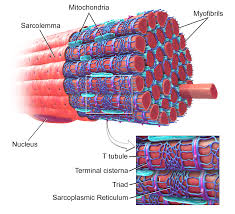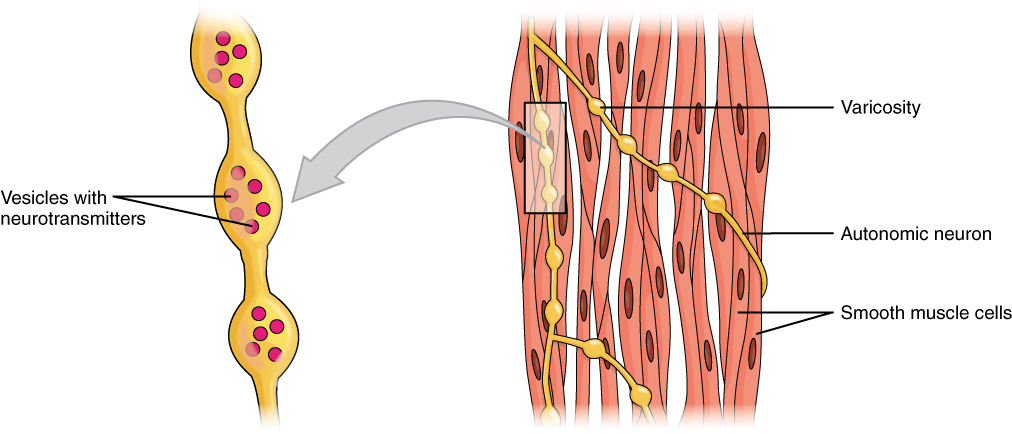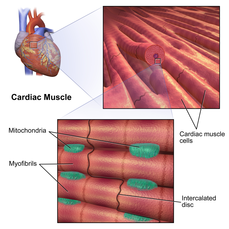Introduction
All types of movements are brought about in the body with the help of muscular tissue. This tissue constitutes the muscles, Which are made up of many long, cylindrical, fibre-like cells called muscle fibres. Muscle fibres in a muscle may be present in the form of sheets or bundles.
The muscle fibres are held together by the connective tissue to form muscles. The muscle fibres contain long thread-like proteinaceous fibres called myofibrils, present in their cytoplasm.
Types muscle:-
On the basis of their location, structure and function; there are three types of muscle fibres:-
Skeletal muscle fibres(Striated or Striped):- These are the most abundant type of muscle fibres found attached to bones, hence, called skeletal muscle fibres. They are voluntary in their activity i.e.; they are under the control of our will power, e.g.; movements of arms, legs etc.
Structure:- In a typical muscle such as the biceps, striated skeletal muscle fibres are bounded from the outside by an elastic but tough covering called sarcolemma. Just beneath the sarcolemma in each fibres, many nuclei occur at irregular intervals.
Thus, these fibres are multinucleated and their nuclei are peripheral in position. The cytoplasm of each fibre has a large number of myofibrils which are tightly packed. Each myofibril shows alternate dark and light bands giving a characteristic striped or striated appearance, hence its name. These fibres are bundled together ina parallel.
Location:- It is found attached to the bones, But, the most common parts to find such muscle are arms, legs, body wall, face and neck.
Function:– .
(i) Movement: Skeletal muscles are primarily responsible for voluntary movements. They attach to bones via tendons and contract to produce motion, enabling activities such as walking, running, lifting, and grasping.
(ii) Posture Maintenance: These muscles help maintain body posture and ensure stability. Continuous, subtle contractions keep the body upright and balanced.
(iii) Support and Protection: Skeletal muscles support and protect internal organs. For example, abdominal muscles help protect the intestines, while back muscles support the spinal column.
(iv) Heat Production: Muscle contractions generate heat as a byproduct of metabolism, playing a crucial role in maintaining body temperature, particularly during shivering.
(v) Metabolic Regulation: Skeletal muscles are significant sites for glucose uptake and storage, aiding in blood sugar regulation. They also store energy in the form of glycogen.
(vi) Venous Return: Contractions of skeletal muscles, particularly in the legs, help pump blood back to the heart, assisting in venous return and circulation.

2. Smooth muscle fibres (unstriped or Non-striated):- Smooth muscles are found in the walls of the hollow visceral organs excepts that of the heart, that is why are called visceral muscles.
They are involuntary in their activity i.e.; their functioning cannot be directly controlled by our will.
Structure:- Smooth muscle fibres or cells are elongated and spindle-shaped i.e.; pointed or taper at the ends (fusiform) and broad in the middle. These cells are held together by the cell junctions and are bundled together ina connective tissue sheath.
Each muscle cell is enclosed in a simple plasma membrane. There is a single centrally located oval nucleus in the centre of cytoplasm. So, they are uninucleate. Delicate, contractile threads called myofibrils run longitudinally through the cell. These fibrils do not show any light and dark bands. That is why, they are called smooth or unstriped or non-striated muscle fibres.
Location:- They are found in the posterior part of oesophagus, stomach, intestine, lungs, urinogenital tract, urinary bladder, blood vessels, iris of the eye etc.
Function:-
(i) Regulation of Blood Flow and Pressure: Smooth muscle fibers in the walls of blood vessels contract and relax to regulate the diameter of the vessels, thereby controlling blood flow and pressure. This process, known as vasoconstriction and vasodilation, is crucial for maintaining homeostasis.
(ii) Movement of Substances in Hollow Organs: Smooth muscle fibers in the walls of hollow organs like the intestines, stomach, and bladder contract rhythmically to propel substances through the organ. This movement, called peristalsis in the digestive tract, ensures the proper progression of food, urine, and other contents.
(iii) Control of Airway Diameter: In the respiratory system, smooth muscle fibers in the bronchial walls regulate the diameter of the airways. This control is vital for managing airflow to and from the lungs, ensuring efficient gas exchange.
(iv) Regulation of Iris and Lens Shape: In the eye, smooth muscle fibers in the iris control the size of the pupil, regulating the amount of light entering the eye. Smooth muscle fibers in the ciliary body adjust the shape of the lens, aiding in focusing vision.
(v) Involuntary Contractions: Smooth muscle fibers operate involuntarily, controlled by the autonomic nervous system and various hormones. This automatic regulation allows smooth muscles to function continuously without conscious effort, essential for processes like digestion, circulation, and respiration.

3. Cardiac muscle fibres (Striated or Striped):- Cardiac muscles are exclusively present in the heart. They are involuntary in their activity.
Structure:- Cardiac muscles are composed of branched fibres. Each fibre or cell is surrounded by sarcolemma and has cytoplasm (sarcoplasm) with longitudinal myofibrils and a centrally located nucleus (i.e.; each cell is uninucleate).
The myofibrils have transverse faint dark and light bands, which alternate with each other. Cardiac muscles fibres also show the presence of sarcomeres
Location:- Cardiac muscles occur in the walls of heart.
Function:-
(i) Pumping Blood: The primary and most critical function of cardiac muscle fibers is to contract rhythmically and forcefully to pump blood throughout the body. This ensures the delivery of oxygen and nutrients to tissues and the removal of carbon dioxide and metabolic wastes.
(ii) Synchronized Contractions: Cardiac muscle fibers are connected by intercalated discs, which contain gap junctions and desmosomes. These structures allow for the rapid and coordinated transmission of electrical impulses across the heart muscle, ensuring that the heart contracts as a single, unified organ, thus maintaining efficient blood flow
(iii) Automaticity: Cardiac muscle fibers have the inherent ability to generate their own electrical impulses without external stimuli, a property known as automaticity. This allows the heart to maintain a consistent and rhythmic heartbeat, which is modulated by the autonomic nervous system and various hormones to meet the body’s changing needs
(iv) Resistance to Fatigue: Unlike skeletal muscles, cardiac muscle fibers have a high density of mitochondria, the energy-producing organelles, which enables them to produce a continuous supply of ATP (adenosine triphosphate). This high energy production capacity allows cardiac muscles to function tirelessly throughout an individual’s life
(v) Adaptation to Increased Demand: Cardiac muscle fibers can adapt to increased physical demands by undergoing hypertrophy, which is an increase in the size of the muscle cells. This adaptation is essential for athletes and individuals with increased cardiovascular demands, ensuring that the heart can pump more effectively when needed.

Differences between Skeletal, Visceral and Cardiac Muscles
Skeletal Muscles | Visceral Muscles | Cardiac Muscles |
1. Occur in the limbs, body wall, face, neck etc. | 1. Occur in posterior part of oesophagus, urinogenital tract, irus of eye etc. | 1. Occur in the walls of heart. |
2. Cylindrical in shape. | 2. Spindle shaped. | 2. Cylindrical in shape. |
3.Multinucleated muscle fibres | 3. Uninucleated muscle fibres. | 3. Uninucleated muscle fibres |
4. Nuclei are peripheral | 4. Nucleus is central | 4. Nucleus is central |
5. Myofibrils show alternate light and dark bands. | 5. Myofibrils are without light and dark bands. | 5. Myofibrils show faint light and dark bands. |
6. Fibres are unbranched. | 6. Fibres are unbranched. | 6. Fibres are branched. |
7. intercalated discs are absent. | 7. intercalated discs are absent. | 7. Intercalated discs are present. |
8. They soon get fatigued | 8. They do not get fatigued. | 8. They never get fatigued. |
9. Voluntary in action. | 9. Involuntary in action | 9. Involuntary in action. |
Skeletal muscles contract through a process called the sliding filament theory, where actin and myosin filaments slide past each other, shortening the sarcomere, the basic unit of a muscle’s cross-striated myofibril.
Voluntary Muscles: Controlled consciously (e.g., skeletal muscles).
Involuntary Muscles: Operate without conscious control (e.g., cardiac and smooth muscles).